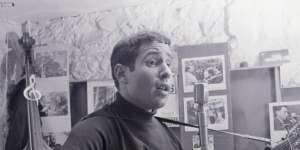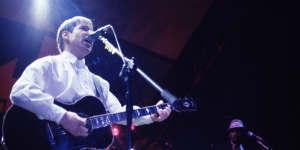Out of that has comeIn Restless Dreams,the title taken from a line in the song that the history of American popular music now knows asThe Sounds of Silence. Simon gave Gibney complete editorial control over the two-part,209-minute film,with one proviso:“The music has to sound good.” It does,although there was apparently some disagreement over whether or not the fluffed recording takes should be included. It appears that they have been.

Paul Simon performs at the Jacquard Club in Norwich in 1965.Archant
Gibney says he encountered several surprises during the shoot. One was that the cantankerous Simon he’d been warned about was nowhere to be found. Another was that Simon was prepared to talk openly about the near-total in his left ear that developed during the production ofSeven Psalms. It means that he now cannot hear a number of frequencies. But,in a moving sequence in the film,he insists that the setback is not so much a limitation on his musicianship as it is “a piece of information that you can work around”.
However,the biggest surprise for Gibney was that watching Simon putSeven Psalms together and talking to him about it helped him find a shape forIn Restless Dreams. Near the start,Simon says that he thinks they’re both basically doing the same thing,“looking for the story”. Which is exactly what Gibney does as he follows Simon’s trial-and-error trek from studio to studio across the country,and works his way through the vast archival material available to him as a filmmaker.
Earlier this year,at CPH:DOX,Copenhagen’s international documentary festival,Gibney acknowledged Simon’s influence on his approach. “It’s not until I went to watch him createSeven Psalms,and found an interesting way of exploring his creative process,that I saw how the finished film needed to be about time and mortality. And,for me,understanding how to stylistically put it all together was a breakthrough.”
As a result,In Restless Dreams is one of the most intimate and revealing studies of a musician’s methods that you’re ever likely to see. Simon reflects extensively on his art,explaining how he has to allow himself to surrender to the stream of his consciousness and trust where it takes him. “Music comes out of where you don’t know,” he tells Gibney at the end of the film. “It speaks in a way that doesn’t have to be precise … It’s a big mystery.”

Paul Simon in Alex Gibney’s documentaryIn Restless Dreams.Docplay
A commitment to that kind of thinking about the creative process also appears to drive Gibney’s film. It opens in 2021 at the small studio on the singer’s ranch in Wimberley,Texas,then moves back and forth across Simon’s career,delving into what makes him tick and how he composes his music. Implicit in his method is a parallel between what he’s doing and Simon’s quest to find the right sounds for his new recording.
Gibney’s route takes him back to his subject’s adolescence in Queens,NY,where,Simon explains,he wasn’t trying to do anything significant:“My culture was the radio. It wasn’t like I sang the music of Queens.” At high school,he met Art Garfunkel,and their fraught relationship began. Garfunkel declined to be interviewed for the film,but appears regularly via the archival material. After that comes Simon’s journey in search of different sounds. “You never know what you’re gonna find along the way,” he says.
Between the lines,it emerges that he’s forever looking for collaborators,in person or simply via the different approaches to making music that he encounters. After Garfunkel and the Everly Brothers’ harmonies onBye,Bye Love came producer Roy Halee,who contributed enormously to the Simon&Garfunkel partnership as “the third member of our triumvirate”. “We kept tumbling into adventures and discoveries,” says Simon,enthusing about how Halee’s inventiveness influenced the sound of his songs.

In Restless Dreams director Alex Gibney.Andrew Brucker
Then there was the Peruvian music that underscoredCecilia;the South African undertaking that led to Simon’sGraceland recording in 1986;the reggae influence that took Simon to Jamaica and generatedMother and Child Reunion;the West African drumming that fuelledRhythm of the Saints;the Brazilian flavour that pervadesThe Obvious Child. And,finally,the Biblical underpinning to the 33-minuteSeven Psalms,about which friend and fellow music-maker Wynton Marsalis (with whom he recorded 2018’sIn the Blue Light album) says,“When I hear that,I really don’t wanna die.”
There’s wonderful footage of Simon performing,alone or with others. His solo rendering ofAmerican Tune in a darkened studio indicates why he was labelled “the poet of urban melancholy”. The extract from Charles Grodin’s television special,Simon&Garfunkel:Songs of America,broadcast on CBS in 1969,points to the duo’s increasing politicisation. Gibney also includes Aretha Franklin in concert delivering her knockout version ofBridge Over Troubled Water by way of illustrating one of the many ways in which Simon left his mark on others.
Not that he was always happy about that. While Gibney uses Simon’s59th Street Bridge (akaFeelin’ Groovy) to bring the first part of his film to a poignant close,with the youthful Simon and Garfunkel sitting uncomfortably together,Simon toldThe Tonight Show’s Stephen Colbert at a Q&A after a preview of the film why he hates the infectious ditty. “It’s a really good children’s song,” he says. “I used to have to sing it with Artie all the time because it was a hit. But in my own shows I don’t do it unless I make a mistake,and then I do it to punish myself.”

Paul Simon performs at Global Citizen Live in New York in 2021.Evan Agostini/Invision/AP
That Simon has a self-deprecating sense of humour also becomes clear from the footage of his appearances on friend Lorne Michaels’Saturday Night Live. A couple of segments have the diminutive singer shooting hoops with a former Harlem Globetrotter,the towering Connie Hawkins,and spoofing his and Garfunkel’s stage personas in a rendition ofThe Sound of Silence,with a heavily bewigged Grodin as Garfunkel. He and his third wife,singer/songwriter Edie Brickell,met backstage on the show in 1985,and she hilariously remembers their first encounter there for Gibney’s camera.
‘In Restless Dreams’ is one of the most intimate and revealing studies of a musician’s methods that you’re ever likely to see.
The contrasts between the downbeat mood of much of the deliciously harmonic music he made with Garfunkel,and the joyous bounce of songs such asDiamonds on the Soles of Her Shoes and the mischievous wit of50 Ways to Leave Your Lover,evoke the multifaceted personality of their creator.
Gibney’s film is long,but his original cut was an hour longer. A lot was left out,he says,including coverage of Simon’s Broadway musical,The Capeman,which bombed at the box office but which Gibney says he loves (excerpts can be seen on YouTube),and footage of the “demos” Simon did with during his early years in the Brill Building. Perhaps there’s a part three waiting in the wings;perhaps not. Either way,the carefully conceivedIn Restless Dreams delivers insights and pleasures aplenty.
In Restless Dreams:The Music of Paul Simon streams on DocPlay from July 4.
Find out the next TV,streaming series and movies to add to your must-sees..